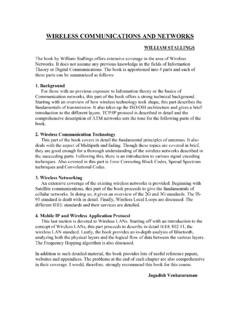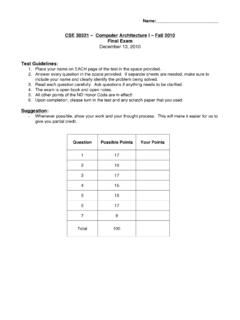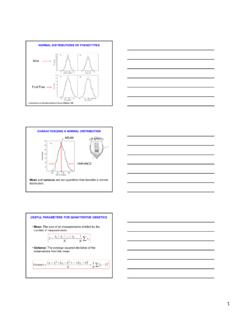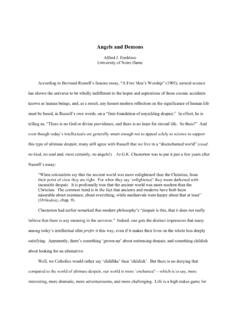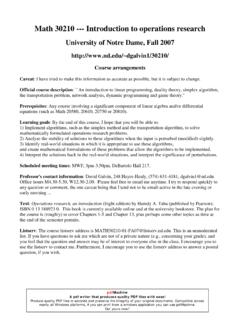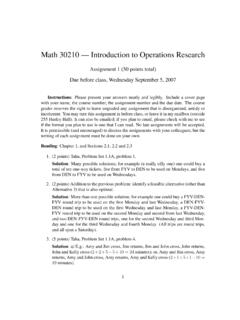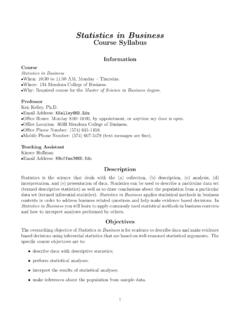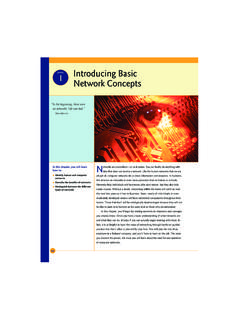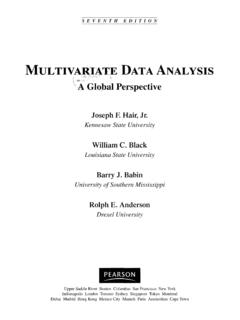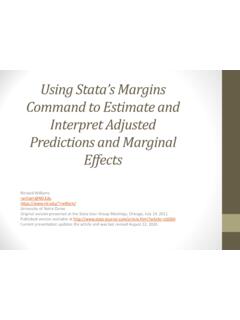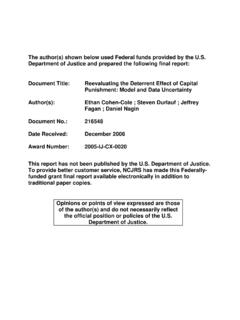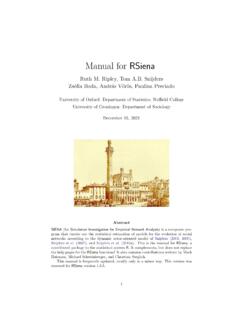Transcription of ordered logit models Understanding and interpreting ...
1 Full Terms & Conditions of access and use can be found by: [Richard Williams]Date: 28 May 2016, At: 08:11 The Journal of Mathematical SociologyISSN: 0022-250X (Print) 1545-5874 (Online) Journal homepage: and interpreting generalizedordered logit modelsRichard WilliamsTo cite this article: Richard Williams (2016) Understanding and interpreting generalizedordered logit models , The Journal of Mathematical Sociology, 40:1, 7-20, link to this article: online: 29 Jan your article to this journal Article views: 212 View related articles View Crossmark dataUnderstanding and interpreting generalized ordered logit modelsRichard WilliamsDepartment of Sociology, university of Notre Dame, Notre Dame, Indiana, United StatesABSTRACTWhen outcome variables are ordinal rather than continuous, the orderedlogit model, aka the proportional odds model (ologit/po), is a popularanalytical method. However, generalized ordered logit /partial proportionalodds models (gologit/ppo) are often a superior alternative.
2 Gologit/ppomodels can be less restrictive than proportional odds models and moreparsimonious than methods that ignore the ordering of categories alto-gether. However, the use of gologit/ppo models has itself been problematicor at least sub-optimal. Researchers typically note that such models fit betterbut fail to explain why the ordered logit model was inadequate or thesubstantive insights gained by using the gologit alternative. This paperuses both hypothetical examples and data from the 2012 European SocialSurvey to address these HISTORYR eceived 21 August 2014 Accepted 27 July 2015 KEYWORDSG eneralized ordered logitmodel; ordered logit model;partial proportional odds;proportional oddsassumption; proportionalodds model1. OverviewTechniques such as Ordinary Least Squares Regression require that outcome variables have interval orratio level measurement. When the outcome variable is ordinal ( , the relative ordering of responsevalues is known but the exact distance between them is not), other types of methods should be the most popular method is the ordered logit model, which (for reasons to be explainedshortly) is also known as the proportional odds , experience suggests that the assumptions of the ordered logit model are frequentlyviolated (Long & Freese,2014).
3 Researchers have then typically been left with a choice between stayingwith a method whose assumptions are known to be violated or switching to a method that is far lessparsimonious and more difficult to interpret, such as the multinomial logit model which makes no useof information about the ordering of this article, we present and critique a third choice: the Generalized ordered logit /PartialProportional Odds Model (gologit/ppo). This model has been known about since at least the 1980s( , McCullagh & Nelder,1989; Peterson & Harrell,1990), but recent advances in software (such asthe user-written gologit and gologit2 routines in Stata) have made the model much easier to estimateand widely used (Fu,1998; Williams,2006).2 The gologit/ppo model selectively relaxes the assump-tions of the ordered logit model only as needed, potentially producing results that do not have theproblems of the ordered logit model while being almost as easy to , while gologit/ppo models have seen increasing use, these uses have themselvesfrequently been problematic.
4 Often it is simply noted that the model fits better and avoids violatingthe assumptions of the ordered logit model (see, , Cornwell, Laumann, & Shumm,2008;Do&CONTACTR ichard Flanner Hall, Department of Sociology, university of Notre Dame, NotreDame, IN 46556, USA1 The ordered probit model is a popular alternative to the ordered logit model. The terms Parallel Lines Assumption and ParallelRegressions Assumption apply equally well for both the ordered logit and ordered probit models . However the ordered probitmodel does not require nor does it meet the proportional odds to Google Scholar, Williams (2006), which introduced the gologit2 program for Stata, has been cited more than 800 timessince its publication. Similarly, various papers by Hedeker ( Hedeker & Mermelstein,1998) on the similar stages of change models have been cited hundreds of times. 2016 Taylor & FrancisTHE JOURNAL OF MATHEMATICAL SOCIOLOGY2016, VOL. 40, NO. 1, 7 20 by [Richard Williams] at 08:11 28 May 2016 Farooqui,2011; Kleinjans,2009; Lehrer, Lehrer, Zhao, & Lehrer,2007; Schafer & Upenieks,2015).
5 However, papers often fail to explain why the proportional odds model was inadequate. Even morecritically, researchers often pay little attention to the substantive insights gained by using the gologit/ppo model that would be missed if proportional odds were used instead. That does not mean thatsuch papers are not making valuable contributions but it could mean that authors are overlookingother important potential contributions of their work. These failings may reflect a lack of under-standing of what the assumptions of these different models actually are and what violations ofassumptions tell us about the underlying reality of what is being article therefore explains why the ordered logit model often fails, shows how and why gologit/ppo can often provide a superior alternative to it, and discusses the ways in which the parameters ofthe gologit/ppo model can be interpreted to gain insights that are often overlooked. We also noteseveral other issues that researchers should be aware of when making their choice of models .
6 By betterunderstanding how to interpret results, researchers will gain a much better Understanding of why theyshould consider using the gologit/ppo method in the first place. Both hypothetical examples and datafrom the 2012 European Social Survey are used to illustrate these The ordered logit /proportional odds modelWe are used to estimating models where a continuous outcome variable,Y, is regressed on anexplanatory variable,X. But suppose the observedYis not continuous instead, it is a collapsedversion of an underlying unobserved variable,Y* (Long & Freese,2014). As people cross thresholds onthis underlying variable their values on the observed ordinal variableYchanges. For example, Incomemight be coded in categories like $0 = 1, $1 $10,000 = 2, $10,001 $30,000 = 3, $30,001 $60,000 = 4,$60,001 or higher = 5. Or, respondents might be asked, Do you approve or disapprove of thePresident s health care plan? The options could be 1 = Strongly disapprove, 2 = Disapprove, 3 =Approve, 4 = Strongly approve.
7 Presumably there are more than four possible values for approval, butrespondents must decide which option best reflects the range that their feelings fall into. For suchvariables, also known as limited dependent variables, we know the interval that the underlyingY* fallsin, but not its exact value. Ordinal regression techniques allow us to estimate the effects of theXsonthe underlyingY*.However, in order for the use of the ordered logit model to be valid, certain conditions must 1-1through1-3present hypothetical examples that clarify what these conditions are and whythey may not be met. Each of these tables presents a simple bivariate relationship between gender andan ordinal attitudinal variable coded Strongly Disagree, Disagree, Agree, and Strongly Agree. In eachtable, a series ofcumulative logit modelsare presented; that is, the original ordinal variable is collapsedTable example of perfect proportional odds/parallel lines*.AttitudeGenderSDDASAT otalMale2502502502501,000 Female1001502505001,000 Total3504005007502,0001 versus 2, 3, 41 & 2 versus 3 & 41, 2, 3 versus 4 OddsM750/250 = 3500/500 = 1250/750 = 1/3 OddsF900/100 = 9750/250 = 3500/500 = 1OR (OddsF/OddsM)9/3 = 33/1 = 31/(1/3) = Beta (OR) ( )Ologit 2(1 ) (p= )Gologit 2(3 ) (p= )Brant Test (2 ) (p= )8R.
8 WILLIAMSD ownloaded by [Richard Williams] at 08:11 28 May 2016 into two categories and a series of binary logistic regressions are run. First it is category 1 (SD) versuscategories 2, 3, 4 (D, A, SA); then it is categories 1 & 2 (SD, D) versus categories 3 & 4 (A, SA); then,finally, categories 1, 2, and 3 (SD, D, A) versus category 4 (SA). In each dichotomization the lowervalues are, in effect, recoded to zero, while the higher values are recoded to one. A positive coefficientmeans that increases in the explanatory variable lead to higher levels of support (or less opposition),while negative coefficients mean that increases in the explanatory value lead to less support (orstronger opposition).If the assumptions of the ordered logit model are met, then all of the corresponding coefficients (exceptthe intercepts) should be the same across the different logistic regressions, other than differences caused bysampling variability. The assumptions of the model are therefore sometimes referred to as the parallel lines orparallel regressions assumptions (Williams,2006).
9 The ordered logit model is also sometimes called the proportional odds model because, if the assumptionsofthemodelaremet,theoddsratio swillstaythesameregardlessofwhichoftheco llapsedlogisticregressions is estimated (hence the term proportional odds assumption is also often used). A test devisedby Brant (1990; also see Long & Freese,2014) is commonly used to assess whether the observed deviationsfrom what the proportional odds model predicts are larger than what could be attributed to chance tables were constructed so that inTable 1-1, the proportional odds/parallel lines assumptionwould be perfectly met. InTables 1-2and1-3we then shifted the distribution of the female responsesso that the assumption would not hold. Although these are hypothetical examples and data, they areTable example of proportional odds violated-I*.AttitudeGenderSDDASAT otalMale2502502502501,000 Female1003003003001,000 Total3505505505502,0001 versus 2, 3, 41 & 2 versus 3 & 41, 2, 3 versus 4 OddsM750/250 = 3500/500 = 1250/750 = 1/3 OddsF900/100 = 9600/400 = = 3/7OR (OddsF/OddsM)9/3 = = (3/7)/(1/3) = Beta (OR).
10 4869136 ( )Ologit 2(1 ) (p= )Gologit 2(3 ) (p= )Brant Test (2 ) (p= )Table example of proportional odds violated-II*.AttitudeGenderSDDASAT otalMale2502502502501,000 Female1004004001001,000 Total3506506503502,0001 versus 2, 3, 41 & 2 versus 3 & 41, 2, 3 versus 4 OddsM750/250 = 3500/500 = 1250/750 = 1/3 OddsF900/100 = 9500/500 = 1100/900 = 1/9OR (OddsF/OddsM)9/3 = 31/1 = 1(1/9)/(1/3) = 1 Beta (OR)0 ( )Ologit 2(1 ) (p= )Gologit 2(3 ) (p= )Brant Test (2 ) (p= )*The tables were constructed so that inTable 1-1, the proportional odds/parallel lines assumption would be perfectly met. InTables1-2and1-3we then shifted the distribution of the female responses so that the assumption would not hold. Although these arehypothetical examples and data, they are typical of what is often encountered in JOURNAL OF MATHEMATICAL SOCIOLOGY9 Downloaded by [Richard Williams] at 08:11 28 May 2016 typical of what is often encountered in practice. InTable 1-1, looking at the column labeled 1 versus 2,3, 4, we see that men are three times as likely to be in one of the higher categories as they are to be inthe lowest category, so the odds for men are 3, 750/250.
